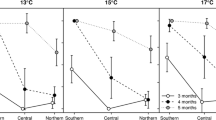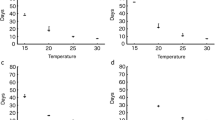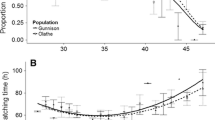Summary
A comparison of pupation-temperature range was made in the laboratory on a temperature gradient (3–38°C) using 12 species ofDrosophila representing four species groups and four different ecological backgrounds (temperate-montane forest:virilis group; desert;repleta group; cosmopolitan:melanogaster group; tropical forest:willistoni group). Within groups, differences are found which usually reflect species' distributions. Comparisons of species' mating-, oviposition- and pupation-temperature ranges reveal that pupation most-often occurs at temperatures beyond those for mating and oviposition. Each species reflects a different combination of temperature effects. Individual species have different temperature-limits for mating, oviposition and pupation. Temperatures permissive for one response are not predictive of limits on other responses. Among species, temperature can affect a particular response differently. Within groups, species differences can be at high and/or low temperatures for any response, and temperature effects among closely related species can manifest themselves in one, or any combination of responses. One cannot predict which responses will be most and least limited, or at which end of the temperature scale a response will be most limited. Among groups,common, but notabsolute temperature ranges generally correspond to the geographic distributions and ecological backgrounds of the species triads. The evaluation of temperature effects on species, based on a single activity, may not be adequate for predicting adaptive strategies.
Similar content being viewed by others
References
Ashburner, M., and Thompson, J.N., Jr, The laboratory culture ofDrosophila, in: The Genetics and Biology ofDrosophila, vol. 2A, pp. 1–109. Eds M. Ashburner, and T. R. F. Wright. Academic Press, London 1978.
Basden, E. B., Diapause inDrosophila (Diptera: Drosophilidae). Proc. R. ent. Soc. Lond., Ser. A29 (1954) 114–118.
Budnik, M., and Brncic, D., Preadult competition between populations ofDrosophila subobscura and established populations ofDrosophila simulans in Chile. Oecologia58 (1983) 137–140.
Cohet, Y., Vouidibio, J., and David, J. R., Thermal tolerance and geographic distribution: a comparison of cosmopolitan and tropical endemicDrosophila species. J. Therm. Biol.5 (1980) 69–74.
Court, A., The climate of the centerminous United States, in: Climates of North America, pp. 193–344. Eds R. A. Bryson and F. K. Hare. Elsevier Scientific Publishing Co., Amsterdam 1974.
Coyne, J. A., Bundgaard, J., and Prout, T., Geographic variation of tolerance to environmental stress inDrosophila pseudoobscura. Am. Nat.122 (1983) 474–488.
Ehrman, L., and Powell, J. R., TheDrosophila willistoni species group, in: The Genetics and Biology ofDrosophila, vol. 3B, pp. 193–225. Eds M. Ashburner, H. L. Carson and J. N. Thompson. Academic Press, London 1982.
Fogleman, J. C., and Markow, T. A., Behavioral differentiation between two species of cactophilicDrosophila. II. Pupation site preference. SWest. Nat.27 (1982) 315–320.
Fogleman, J. C., and Wallace, B., Temperature-dependent development and competitive ability of three species in theD. affinis subgroup. Am. Midl. Nat.104 (1980) 341–351.
Grossfield, J., Non-sexual behavior ofDrosophila, in: The Genetics and Biology ofDrosophila, vol. 2B, pp. 1–126. Eds M. Ashburner and T. R. F. Wright. Academic Press, London 1978.
Ives, P. T., Further studies on the South Amherst population ofDrosophila melanogaster. Evolution24 (1970) 507–518.
Kaneshiro, K. Y., Carson, H. L., Clayton, F. E., and Heed, W. B., Niche separation in a pair of homosequentialDrosophila species from the island of Hawaii. Am. Nat.107 (1973) 766–774.
Manning, M., and Markow, T. A., Light-dependent pupation site preferences inDrosophila. II.D. melanogaster andD. simulans. Behav. Genet.11 (1981) 557–563.
McKenzie, J. A., The influence of low temperature on survival and reproduction in populations ofDrosophila melanogaster. aust. J. Zool.23 (1975) 237–247.
McKenzie, J. A., and McKechnie, S. W., A comparative study of resource utilization in natural populations ofD. melanogaster andD. simulans. Oecologia40 (1979) 299–309.
Mensua, J. L., Some factors affecting pupation height ofDrosophila. Drosoph. Inf. Serv.76 (1967) 42.
Mosiño Aleman, P. A., and Garcia E.. The climate of Mexico, in: Climates of North America, pp. 345–404. Eds R. A. Bryson and F. K. Hare. Elsevier Scientific Publishing Co., Amsterdam 1974.
Parsons, P. A., Adaptive strategies of colonizing animal species. Biol. Rev.57 (1982) 117–148.
Parsons, P. A., and Stanley, S. M., Domesticated and widespread species, in: The Genetics and Biology ofDrosophila, vol. 3A, pp. 349–393. Eds M. Ashburner, H. L. Carson and J. N. Thompson. Academic Press, London 1981.
Ricci, M., and Budnik, M., Influence of temperature, density and interspecific competition on the preadult development of Chilean populations ofDrosophila subobscura andDrosophila immigrans. Braz. J. Genet.VII 2 (1984) 255–264.
Richmond, R. C., Genetic similarities and evolutionary relationships among the semispecies ofD. paulistorum. Evolution26 (1972) 536–544.
Schnebel, E., and Grossfield, J., Mating-temperature range inDrosophila. Evolution38 (1984) 1296–1307.
Schnebel, E., and Grossfield, J., Oviposition-temperature range in fourDrosophila species triads from different ecological backgrounds. Am. Midl. Nat. (1986) in press.
Sokal, R., Ehrlich, P., Hunter, P., and Schlager, G., Some factors affecting pupation site inDrosophila. Ann. ent. Soc. Am.53 (1960) 174–182.
Sokal, R. R., and Rohlf, F. J., Biometry. W. H. Freeman, San Francisco 1981.
Spieth, H. T. The virilis group ofDrosophila and the beaverCastor. Am. Nat.114 (1979) 312–316.
Tantawy, A. O., and Mallah, G. S., Studies on natural populations ofDrosophila. I. Heat resistance and geographical variation inD. melanogaster andD. simulans. Evolution15 (1961) 1–14.
Author information
Authors and Affiliations
Rights and permissions
About this article
Cite this article
Schnebel, E.M., Grossfield, J. Pupation-temperature range in 12Drosophila species from different ecological backgrounds. Experientia 42, 600–604 (1986). https://doi.org/10.1007/BF01955553
Published:
Issue Date:
DOI: https://doi.org/10.1007/BF01955553




